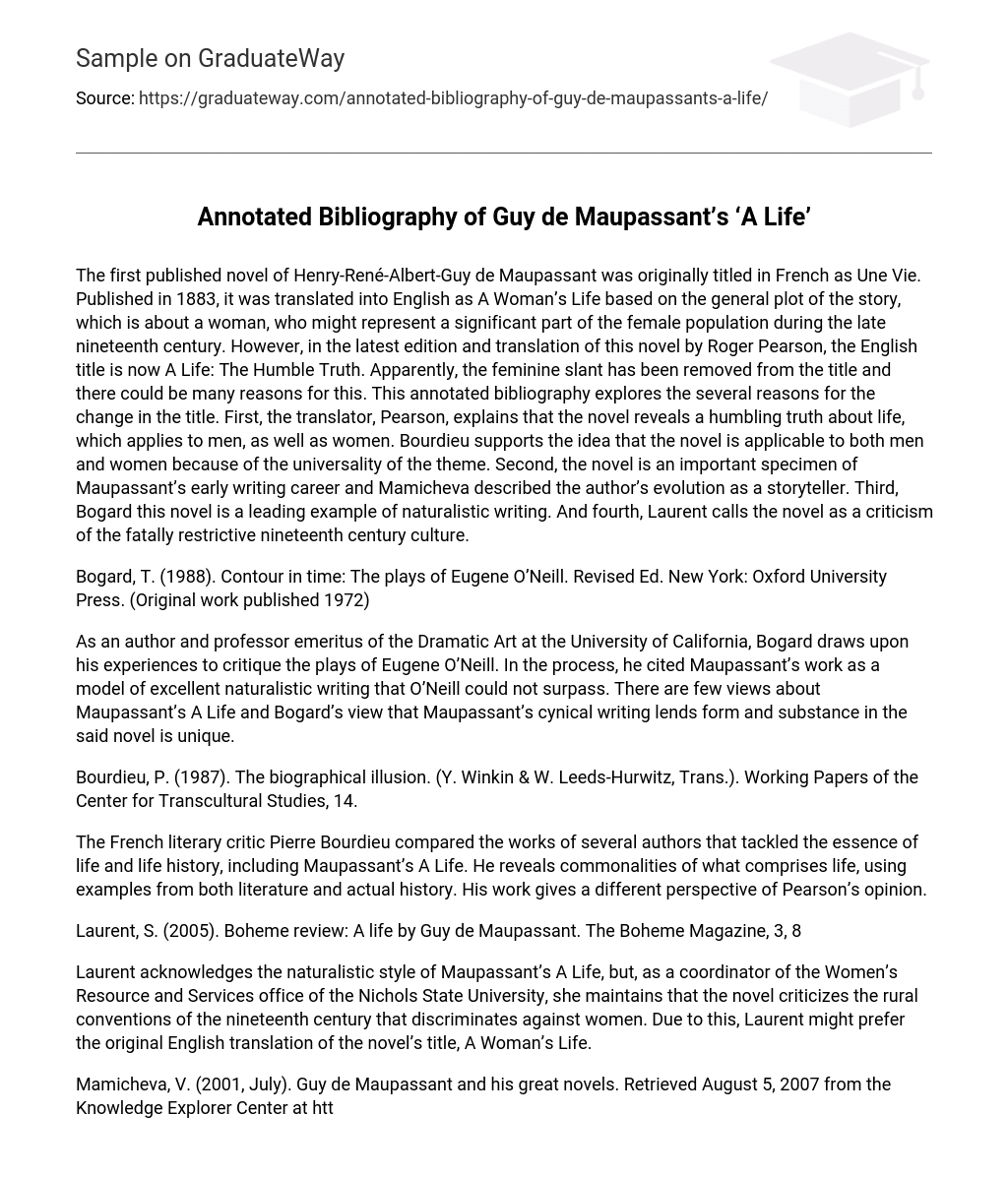The first published novel of Henry-René-Albert-Guy de Maupassant was originally titled in French as Une Vie. Published in 1883, it was translated into English as A Woman’s Life based on the general plot of the story, which is about a woman, who might represent a significant part of the female population during the late nineteenth century. However, in the latest edition and translation of this novel by Roger Pearson, the English title is now A Life: The Humble Truth. Apparently, the feminine slant has been removed from the title and there could be many reasons for this. This annotated bibliography explores the several reasons for the change in the title. First, the translator, Pearson, explains that the novel reveals a humbling truth about life, which applies to men, as well as women. Bourdieu supports the idea that the novel is applicable to both men and women because of the universality of the theme. Second, the novel is an important specimen of Maupassant’s early writing career and Mamicheva described the author’s evolution as a storyteller. Third, Bogard this novel is a leading example of naturalistic writing. And fourth, Laurent calls the novel as a criticism of the fatally restrictive nineteenth century culture.
Bogard, T. (1988). Contour in time: The plays of Eugene O’Neill. Revised Ed. New York: Oxford University Press. (Original work published 1972)
As an author and professor emeritus of the Dramatic Art at the University of California, Bogard draws upon his experiences to critique the plays of Eugene O’Neill. In the process, he cited Maupassant’s work as a model of excellent naturalistic writing that O’Neill could not surpass. There are few views about Maupassant’s A Life and Bogard’s view that Maupassant’s cynical writing lends form and substance in the said novel is unique.
Bourdieu, P. (1987). The biographical illusion. (Y. Winkin & W. Leeds-Hurwitz, Trans.). Working Papers of the Center for Transcultural Studies, 14.
The French literary critic Pierre Bourdieu compared the works of several authors that tackled the essence of life and life history, including Maupassant’s A Life. He reveals commonalities of what comprises life, using examples from both literature and actual history. His work gives a different perspective of Pearson’s opinion.
Laurent, S. (2005). Boheme review: A life by Guy de Maupassant. The Boheme Magazine, 3, 8
Laurent acknowledges the naturalistic style of Maupassant’s A Life, but, as a coordinator of the Women’s Resource and Services office of the Nichols State University, she maintains that the novel criticizes the rural conventions of the nineteenth century that discriminates against women. Due to this, Laurent might prefer the original English translation of the novel’s title, A Woman’s Life.
Mamicheva, V. (2001, July). Guy de Maupassant and his great novels. Retrieved August 5, 2007 from the Knowledge Explorer Center at http://www.shared-visions.com/explore/literature/Maupassant.htm
There is no sufficient information about Mamicheva that will provide a solid wall of credibility, except that she is a prolific reviewer of many literary works and influenced by Tolstoy. With this in mind, her ideas must be taken cautiously. But her proposal that A Life reflects the first stage of Maupassant’s writing career is convincing because she provided an extensive descriptions and interpretations of all six Maupassant novels.
Pearson, R. (1999). Introduction. In G. de Maupassant, A Life: The Humble Truth. (pp. vii – xxix) (R. Pearson, Trans.) New York: Oxford University Press, Inc. (Original work published 1883).
Pearson’s work is a translation of the original French of Maupassant’s novel but he included an introduction that explains his view about why this story must be read. As a literary critic and author himself, Pearson’s major point is that the greatest humbling truth in one’s life is the folly of having unrealistic expectations because this only leads to unhappiness.
Bibliography
Bogard, T. (1988). Contour in time: The plays of Eugene O’Neill. Revised Ed. New York: Oxford University Press. (Original work published 1972)
Bourdieu, P. (1987). The biographical illusion. (Y. Winkin & W. Leeds-Hurwitz, Trans.). Working Papers of the Center for Transcultural Studies, 14.
De Maupassant, G. (1999). A life: The humble truth. (R. Pearson, Trans.) New York: Oxford University Press, Inc. (Original work published 1883).
Laurent, S. (2005). Boheme review: A life by Guy de Maupassant. The Boheme Magazine, 3, 8
Mamicheva, V. (2001, July). Guy de Maupassant and his great novels. Retrieved August 5, 2007 from the Knowledge Explorer Center at http://www.shared-visions.com/explore/literature/Maupassant.htm
Pearson, R. (1999). Introduction. In G. de Maupassant, A Life: The Humble Truth. (pp. vii – xxix) (R. Pearson, Trans.) New York: Oxford University Press, Inc. (Original work published 1883).





